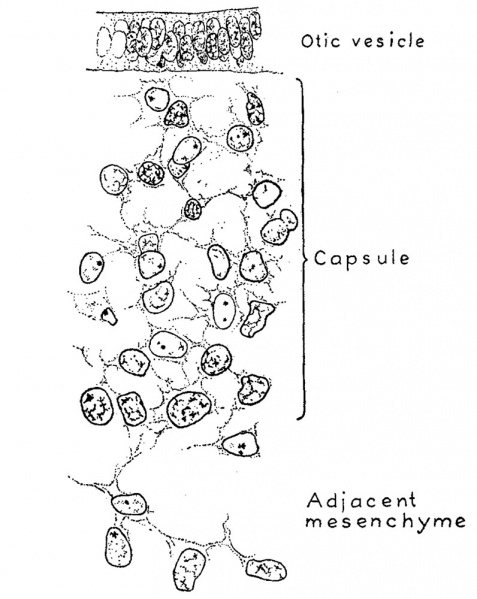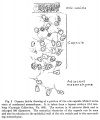File:Streeter1917 fig03.jpg

Original file (796 × 1,000 pixels, file size: 117 KB, MIME type: image/jpeg)
Fig. 3. Otic capsule human embryo 13.5 mm long
Camera lucida drawing of a portion of the otic capsule while it is the state of condensed mesenchyme. It is taken from a human embryo 13.5 mm. long (Carnegie Collection, No. 695). The section is 10 microns thick and is enlarged 950 diameters. The syncytial character of the capsule can be seen and also its relation to the epithelial wall of the otic vesicle and to the surrounding mesenchyme.
On the median side of the vesicle this zone is lacking, although there is a considerable number of mesenchyme cells clustered around the vascular plexus ensheathing the central nervous system, and among the nerve rootlets of the acoustic complex. When this zone is analyzed under higher magnification it is found that it still consists essentially of a mesenchymal syncytium. It differs morphologically from the adjacent mesenchyme, with which it is directly continuous, only in its more numerous and more compactly arranged nuclei and its somewhat richer network of internuclear processes. This is shown in figure 3 which is taken from an embryo a little larger than that in figure 2, but which in its general form is apparently in about the same stage of development.
| Historic Disclaimer - information about historic embryology pages |
|---|
| Pages where the terms "Historic" (textbooks, papers, people, recommendations) appear on this site, and sections within pages where this disclaimer appears, indicate that the content and scientific understanding are specific to the time of publication. This means that while some scientific descriptions are still accurate, the terminology and interpretation of the developmental mechanisms reflect the understanding at the time of original publication and those of the preceding periods, these terms, interpretations and recommendations may not reflect our current scientific understanding. (More? Embryology History | Historic Embryology Papers) |
- Links: Fig 1 | Fig 2 | Fig 3 | Fig 4 | Fig 5 | Fig 6 | Fig 7 | Fig 8 | Fig 9 | Fig 10 | Streeter 1917 | Historic Embryology Papers | Carnegie Embryos
Reference
Streeter GL. The factors involved in the excavation of the cavities in the cartilaginous capsule of the ear in the human embryo. (1917) Amer. J Anat. 22: 1–25.
Cite this page: Hill, M.A. (2024, April 25) Embryology Streeter1917 fig03.jpg. Retrieved from https://embryology.med.unsw.edu.au/embryology/index.php/File:Streeter1917_fig03.jpg
- © Dr Mark Hill 2024, UNSW Embryology ISBN: 978 0 7334 2609 4 - UNSW CRICOS Provider Code No. 00098G
File history
Click on a date/time to view the file as it appeared at that time.
| Date/Time | Thumbnail | Dimensions | User | Comment | |
|---|---|---|---|---|---|
| current | 08:55, 30 October 2015 |  | 796 × 1,000 (117 KB) | Z8600021 (talk | contribs) | |
| 08:54, 30 October 2015 |  | 1,251 × 1,500 (246 KB) | Z8600021 (talk | contribs) |
You cannot overwrite this file.
File usage
The following 2 pages use this file:
